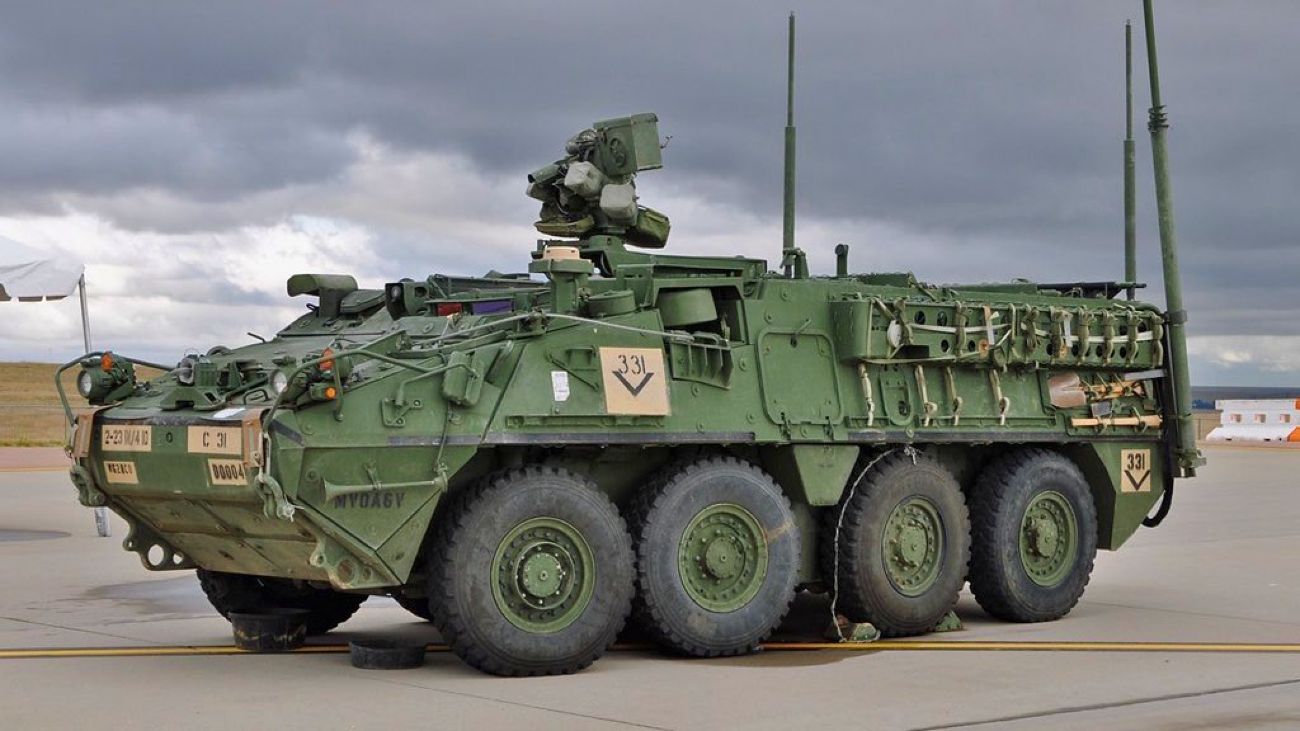India, US Stryker AFV Deal Bludgeons ‘Make In India’ Initiative; Massive Setback For Mahindra & Tata Group
Following the annual 2+2 ministerial consultations held between the foreign and defense ministers of India and the US in New Delhi on November 10, a senior US defense official reportedly announced that the US and India will co-produce Stryker armored fighting vehicle (AFV).
The joint statement issued following the consultations merely alludes to the deal.
Looking ahead, the Ministers welcomed the progress achieved towards the co-production and co-development of defense systems, noting their mutual interest to co-develop and co-produce ground mobility systems as they bring the two countries’ respective defense sectors closer together while enhancing Indian capabilities.
US Stryker AFV vs India’s WhAP
The Stryker is a family of eight-wheeled armored fighting vehicles produced by General Dynamics Land Systems-Canada (GDLS-C) for the United States Army in a plant in London, Ontario. It has four-wheel drive (8×4) and can be switched to all-wheel drive (8×8).
The Indian government’s decision to co-produce the Stryker AFV in India must come as an unpleasant surprise to Indian defense enthusiasts who have championed the current Indian government’s push for locally developed weapon systems.
Indeed, the Indian government’s decision to co-produce the Stryker with the US is confounding, to say the least.
Over the past 10 years, two leading Indian private sector firms – Tata Motors and Mahindra – have successfully collaborated with DRDO’s Vehicle Research & Development Establishment (VRDE) to develop an AFV based on very stringent specifications of the Indian Army.
The result of their collaboration has been proudly displayed at the biannual Weapons trade fair DefExpo since 2014. It is difficult to understand the imperative for procuring the Stryker now when we have already developed a weapon system locally.
Make In India, Buy From The US?
The MoD had earlier selected Tata Motors and Mahindra to develop a Wheeled AFV under the guidance of the Vehicle Research & Development Establishment (VRDE). Tata Motors shocked VRDE by developing the entire platform in just 18 months! The AFV, named Kestrel, was first unveiled at DefExpo 2014.
Based on user trials and suggestions, many design improvements were incorporated into the Kestrel design.
During DefExpo 2018, Tata Motors unveiled a new variant of the Kestrel to meet the enhanced qualitative requirements of DRDO’s Wheeled Amphibious Armoured Platform (WhAP).
The WhAP is a multi-utility armored platform with a modular design, configurable for a variety of combat and combat-support roles, weighing up to 26t Gross Vehicle Weight (GVW).
Tata Motor’s WhAP has a weight of around 25 tons and is powered by a 600-hp diesel engine. It can reach a maximum road speed of 100 km/h. For amphibious operations, the WhAP is propelled in the water at a maximum speed of 10 km/h thanks to two hydrojets mounted at the rear of the vehicle.
During DefExpo 2020, the erstwhile Ordnance Factory Board (OFB) revealed its version of the WhAP IFV based on Tata Motors’ Kestrel. (VRDE is now honing the Kestrel platform with the help of subsequent phase L1 bidder Mahindra Group.)
The OFB vehicle is powered by a Cummins ISXe 600 turbocharged diesel engine coupled to an automatic transmission. The platform is available in both an 8×8 and an 8×4 configuration.
“The vehicle’s protection meets STANAG 4569 requirements, with actual protection levels depending on the task,” a DRDO official told Jane’s. The modular protection results in the platform’s weight varying between 19 and 26 tonnes, with amphibious capability provided at up to 24 tonnes. The WhAP, which can reach a top speed of 100 km/h on land, has a cruising range of up to 500 km.
The OFB WhAP is armed with the manned turret from the BMP-2. “It is the most cost-effective solution for the IA,” said the DRDO official, pointing out that the turret is fitted with a 30 mm 2A42 main gun, a Kalashnikov PKT 7.62 mm coaxial machine gun, and a roof-mounted launcher for the AT-4 Spigot anti-tank missile system.
The Bloomberg report, quoting an unnamed Indian official, states that India wants to co-produce ‘thousands of’ vehicles, most of which will be armed with anti-tank missile systems. The rest will be used for battlefield surveillance or as command vehicles.
Clearly, the Stryker co-production could completely derail local development of AFVs and leave Tata Motors and Mahindra, if not the entire private sector, skeptical about the government’s much-hyped Make-in-India slogan
Is US Pressure At Work?
Based on open-source evidence, it does appear that the Make-in-India paradigm doesn’t apply to acquiring defense systems from vendors in Israel and the US without ToT.
The doubts emanate from the government’s earlier decisions to acquire MALE drones from Israel and now AFVs from the US, both weapon systems that India has already developed locally!
The Bloomberg report raises questions that go far beyond India’s quest for local development and production of weapon systems for our armed forces.
Is the Indian government under pressure from the US and its allies to buy weapon systems from the West?
Indian corporate media, which appears to be heavily influenced by Western agencies, has been promoting the narrative that Western weapon systems are more effective than Russian weapon systems. The narrative is true in some cases but contextually misleading.
While some Western weapon systems may be more effective than Russian weapon systems, Western systems are invariably less cost-effective than Russian systems.
The myth of the superiority of Western weapon systems has been shattered in Ukraine during the course of Russia’s Special Military Operation (SMO). The Bloomberg report hilariously states, “The vehicles (Stryker) will help India push back China along their disputed border.”
Placing Stryker AFVs along the LAC will prompt the PLA to withdraw. Really?
The report quotes an Indian official, speaking on condition of anonymity, as saying the majority of the vehicles will be deployed along India’s border with China.
If the anonymous Indian official did say as much, the official was likely off medication. The Indian Army is not known to formulate its operational deployment plans years before acquiring a weapon and then leak them to a Western media source!
(Actually, when the WhAP RFI was floated, the army stated that it planned to use these AFVs in the plain sectors of Punjab and Rajasthan. But, of course, Army plans are subject to change based on operational requirements, not any whimsical thinking of anonymous, possibly fictitious, Western media sources.)
The Biden administration gifted Strykers to Ukraine, along with Bradley fighting vehicles and Abrams tanks, to fight Russian forces deployed in Ukraine as part of the SMO.
Ukraine used the US armored vehicles in their much-hyped counter-offensive using NATO high mobility warfare tactics. Both the Stryker and the Bradley, not to mention NATO tactics, made little impact on Russian defenses. Ukraine sustained heavy losses of the armored vehicles, and the counter-offensive failed almost completely.
Russian President Vladimir Putin wasn’t being entirely facetious when he quipped of Western armor, “It burns well!”
Is India Compromising Its Sovereignty?
The Bloomberg report goes on to unabashedly add that the Stryker co-production deal will reduce “New Delhi’s long-term dependence on Russian weapons,” clearly implying that India is trying to reduce its long-term dependence on Russian weapons!
The Indian government’s stated policy is to reduce India’s dependence on imported weapon weapon systems. Reducing dependence on Russian weapons by importing US weapons is certainly not the Indian government’s stated policy. At best, it’s delusional thinking on the part of the US leadership. More likely, it’s an assault on Indian sovereignty!
If an Indian publication operating in the US had carried a report such as the Bloomberg report, the US government would have promptly declared the publication as a foreign agent interfering in US internal affairs.
Conclusion
The Stryker co-production deal between India and the US is arguably the most bizarre defense acquisition deal in recent times. It makes little sense, even assuming panic over the Chinese threat!
It appears to make a mockery of India’s quest for local development and production of weapon systems. It rides roughshod on the development efforts and expenses of two very reputed and capable Indian private sector companies.
Knowing the proclivity of the US to impose illegal sanctions, the deal appears to compromise Indian security.
If it’s indeed the government’s policy to distance India from Russia, the government needs to tell Indian citizens why it makes more sense to procure weapon systems that can be produced locally from the US without any ToT.
Why not from Russia, a reliable supplier with a track record of transferring to India sensitive technologies such as nuclear propulsion for submarines, cryogenic rocket engines, ramjet engines, missile seekers, and supersonic cruise missiles?
Rhetorical question – Is it because we have not suffered enough earlier from US sanctions?
US, India will co-produce Stryker armored fighting vehicle (AFV). Delhi's decision for Stryker AFV is an unpleasant news for Tata & Mahindra

www.eurasiantimes.com

 www.eurasiantimes.com
www.eurasiantimes.com


 en.wikipedia.org
en.wikipedia.org
